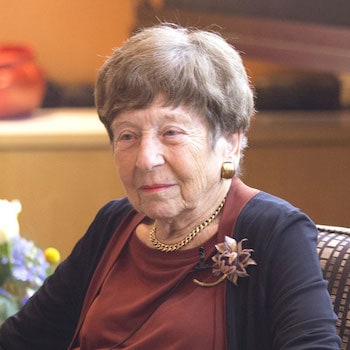Location
2131 CSRB Climate & Space Research Building
2455 Hayward Street
Ann Arbor, MI 48109-2143
Phone
Primary Website
Education
- A.B, A.M., Ph.D., Radcliffe College, Harvard University
Professional Service
Kivelson has been a Harvard Overseer and a Councillor of the National Academy of Sciences. She has served on numerous advisory committees including the Space Studies Board of the National Research Council and on scientific Visiting Committees at Harvard, various campuses of the University of California and the Jet Propulsion Laboratory. She is serving on. the Steering Committee for the Decadal Survey (2010) of Planetary Sciences. She lectures on space research to K-12 students and other general audiences. She has been active in efforts to identify the barriers faced by women as students, faculty and practitioners of the physical sciences and to improve the environment in which they function.
Research Interests
Theory and data analysis of fields and particles in the solar system: properties of the internal magnetic fields of moons and planets, investigation and interpretation of fundamental magnetohydrodynamic processes in planetary magnetospheres and in the solar wind.
Professor Kivelson’s research investigations are in the areas of solar terrestrial physics and planetary science with a focus on the particles and magnetic fields of interplanetary space and the wave excitations that couple them. Her interests extend from Earth to Jupiter, Saturn and Jupiter’s Galilean moons. The Web of Science shows more than 9000 citations to her research papers.
Among her most heavily cited papers are a paper announcing the discovery of cavity mode oscillations in the magnetosphere (“Global compressional oscillations of the terrestrial magnetosphere – The evidence and a model,” J. Geophys.Res., 1984, 121 citations) and papers with D. J. Southwood developing the theory (“Resonant ULF waves: A new interpretation,” Geophys. Res. Lett., 1985, 221 citations; “Coupling of global magnetospheric MHD eigenmodes to field line resonances,” J. Geophys. Res., 1986; 268 citations; “Analytic formulation and quantitative solutions of the coupled ULF wave problem,” J. Geophys. Res., 1988, 98 citations). With D. J. Southwood, she developed new ways of describing wave-particle interactions in magnetohydrodynamic waves, wrote influential papers on the linear and non-linear growth of mirror mode waves and provided new insight into the mechanism of interchange diffusion in rotating plasmas. Her work with Z. Y. Pu on Kelvin-Helmholtz waves laid the foundation for much of the later work on this subject (“Kelvin-Helmholtz instability at the magnetopause – solution for compressible plasmas,” J. Geophys. Res. , 1983, 115 citations). With A. Ridley (of U. Michigan) she developed a new way of interpreting the phenomenon of saturation of the cross polar cap potential during magnetic storms.
Her focus on the magnetospheres of the outer planets and plasma interactions with their moons started with interpretation of data from the Pioneer 10 and 11 spacecraft in the 1970s. Thereafter, she was selected as the Principal Investigator for the Magnetometer on the Galileo Orbiter that acquired data in Jupiter’s magnetosphere for eight years. Using Galileo data, she and her team discovered the magnetic field of Ganymede and inferred the presence of subsurface oceans on Europa and Callisto, and possibly on Ganymede. Using magnetometer data, she identified the role of small spatial scale interchange as a mechanism of transport at Jupiter, an interpretation that was quickly supported by data from other investigations on the mission. Recent work, again with D. J. Southwood, is using Cassini data to provide insight into the periodic variations of the magnetic field and other associated phenomena at Saturn. Kivelson continues to contribute to studies of the outer planets as a member of the Cassini Magnetometer team and to investigations of the terrestrial magnetosphere as a Co-I on the NASA-ESA Cluster mission and the THEMIS mission.
Awards
Kivelson’s honors include a Radcliffe Institute Fellowship in 1965-66. a Guggenheim Fellowship (1973-74), the Radcliffe Graduate Society Medal (1983), the Harvard University 350th Anniversary Alumni Medal (1986), several NASA Group Achievement Awards, and memberships in the American Academy of Arts and Sciences, the National Academy of Sciences and the American Philosophical Society, the oldest scholarly society in the United States. She is a Fellow of the American Geophysical Union, the American Physical Society, the International Academy of Astronautics, and the American Association for the Advancement of Science. She was awarded the Alfvén Medal of the European Geophysical Union and the Fleming Medal of the American Geophysical Union.
Publications
Kivelson has published more than 300 research papers and edited several books. She was the co-editor of a widely used textbook on space physics.
See web page: http://www.igpp.ucla.edu/people/mkivelson.html for access to her publication record and electronic versions of most of them.
